|
80x5 -
240x3 -
240x4 -
320x1 -
320x2 -
320x3 -
640x1 -
640x2
Set display option above.
Click on
images to enlarge. |
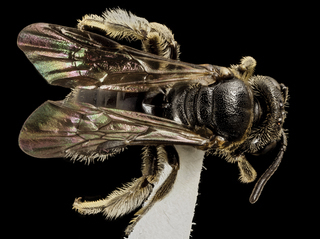
© Copyright source/photographer
· 5
Pseudopanurgus labrosiformis, f, ga, baker, back |
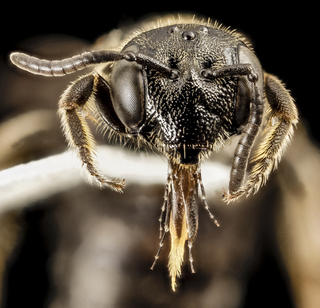
© Copyright source/photographer
· 5
Pseudopanurgus labrosiformis, f, ga, baker, face |
|
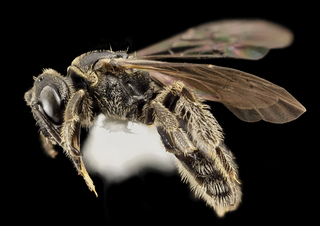
© Copyright source/photographer
· 5
Pseudopanurgus labrosiformis, f, ga, baker, side |
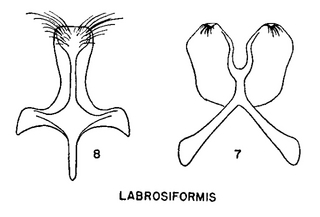
© Copyright source/photographer
· 1
Pseudopanurgus labrosiformis, figure64d |
|
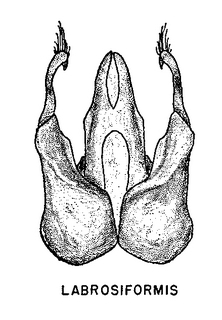
© Copyright source/photographer
· 1
Pseudopanurgus labrosiformis, figure66i |
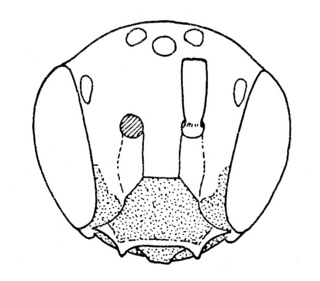
© Rebekah Andrus Nelson
· 1
Pseudopanurgus labrosiformis, male, face |
|
Overview |
Reprinted with permission from: Mitchell, T.B. 1960 Bees of the Eastern United States. North Carolina Agricultural Experiment Station Technical Bulletin No. 141.
FEMALE—Length 5.5 mm.; piceous; face slightly longer than distance between eyes above; eyes subparallel; cheeks subequal to eyes in width; process of labrum nearly as long as its basal width, much narrowed apically, apex narrowly truncate and slightly emarginate; facial foveae shallow but distinct, narrow, terminating at level of antennae; lateral ocelli slightly nearer margin of vertex than to each other; median segments of flagellum about as broad as long, apical ones somewhat longer; punctures of head rather coarse and shallow, rather widely separated below antennae, quite close above but not crowded, becoming very fine and sparse on the shining cheeks below; pubescence of head and thorax short, thin, entirely pale; tegulae yellowish-hyaline; wings hyaline, veins yellowish, stigma more brownish, 2nd recurrent vein entering 2nd submarginal cell much nearer apex that 1st does to base; legs dark, spurs yellowish; punctures of scutum and scutellum somewhat coarser and deeper than those of face, well separated but not sparse, surface shining; pleura shining, punctures more shallow and sparse; apical margins of abdominal terga rather broadly and shallowly depressed, these areas quite smooth, somewhat reddened, discs of terga smooth and shining, very minutely and rather closely punctate except toward the depressed apical rims, discal pubescence very thin and sparse, forming a rather dense, yellowish, apical fimbria on tergum 5.
MALE—Length 5 mm.; piceous; face considerably longer than distance between eyes above; eyes slightly convergent below; most of clypeus, process of labrum and mandibles except tips, yellow, the apical, lateral margins of clypeus dark; face with triangular, lateral maculae, which extend along eye margins considerably above upper margin of clypeus; cheeks considerably narrower than eyes; process of labrum nearly as long as its basal width, strongly narrowed apically, apex narrowly truncate and slightly emarginate; facial foveae distinct but very small, terminating considerably above level of antennae; lateral ocelli somewhat nearer margin of vertex than to each other; median segments of antennae very slightly longer than broad; punctures of head rather coarse and deep, close over antennae, becoming rather sparse below antennae, and very shallow and sparse on cheeks below; pubescence of head and thorax thin, short, entirely pale; tegulae yellowish-hyaline; tubercles somewhat reddened, but thorax otherwise dark; wings hyaline, veins yellowish, stigma more brownish, recurrent veins entering 2nd submarginal cell subequally distant from base and apex; tarsi yellow, mid and hind tibiae piceous except for yellow base and apex, the front tibiae yellow over anterior face, dark posteriorly; spurs yellow; punctures of scutum and scutellum deep and distinct, rather coarse, well separated but not sparse; pleura shining and more sparsely punctate above, punctures becoming close and rather fine beneath; abdominal terga rather narrowly and deeply depressed apically, these areas smooth and impunctate, disc of tergum 1 smooth, rather sparsely and finely punctate, those of 2nd and following segments very finely roughened basally but becoming distinctly and rather finely and closely punctate toward the depressed rims; discal pubescence very short, thin and sparse, entirely pale; sternum 6 with a narrow and deep, median, apical emargination; wings of sternum 7 semi-circular, bearing a small apical tuft of setae; apical process of ternum 8 parallel-sided, rather narrowly truncate apically, with a few apical setae; gonostyli carinate beneath basally, this carina bearing a fringe of short setae, the apex narrowly acute and abruptly flexed, bearing a subapical tuft of long setae; penis valves rather slender, about equal in length to gonostyli.
DISTRIBUTION—Illinois, North Carolina and Georgia; August.
FLOWER RECORDS—Robertson (1929) records this on Actinomeris alt ernif olia, Bidens aristosa, Coreopsis trip tens, Helianthus divaricatus, H. tub erosus, Heliopsis helianthoides, Rudbeckia laciniata, R. tnloba, Silphium per foliatum and Solidago canadensis.
A subspecies, P. labrosiformis distractus Cockerell, described from Nebraska, does not appear to occur east of the Mississippi.
|
|
|
Names | |
|
|
| Supported by | |
Updated: 2024-04-26 14:27:52 gmt
|